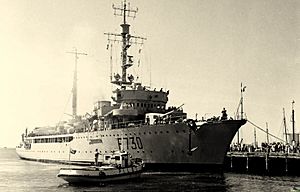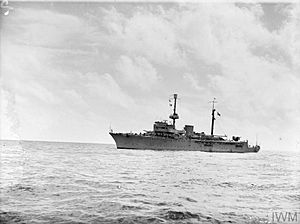Italian sloop Eritrea facts for kids

Francis Garnier
|
|
Quick facts for kids History |
|
|---|---|
| Name | Eritrea |
| Ordered | 8 May 1935 |
| Launched | 28 September 1936 |
| Completed | 10 February 1937 |
| Fate | Transferred to France 1948 |
| Name | Francis Garnier |
| Namesake | Francis Garnier |
| Acquired | 12 February 1948 |
| Stricken | 1966 |
| Fate | Sunk as target ship 1966 |
| General characteristics | |
| Type | Colonial ship |
| Displacement |
|
| Length | 96.9 m (317 ft 11 in) |
| Beam | 13.3 m (43 ft 8 in) |
| Draught | 4.7 m (15 ft 5 in) |
| Propulsion | 2-shaft diesel-electric, 7,800 hp diesel, 1,300 hp electric motors |
| Speed | 20 knots (23 mph; 37 km/h) |
| Range | 6,950 nmi (12,870 km) |
| Complement | 234 |
| Armament |
|
| Armour |
|
Eritrea was a special ship built for the Italian Royal Navy. It was designed to work in faraway places like the Indian and Pacific Oceans. Built in Italy, it started service in 1937. Later, after World War II, it was given to France and renamed Francis Garnier.
Contents
About the Eritrea Ship
What Was the Eritrea Designed For?
The Eritrea was built as a "colonial ship." This meant it was made for long trips and duties far from Italy. It was sometimes called a "sloop." The ship had a special diesel-electric engine. This engine helped it travel very long distances without needing to refuel often.
What Weapons Did It Carry?
The Eritrea was armed with four large 120 mm guns. It also had two 40 mm guns and four 13.2 mm machine guns. The ship even had a workshop on board. This allowed it to help repair Italian submarines in East Africa. There were plans for a similar ship called Etiopia. However, this plan was cancelled when World War II began.
Eritrea's Service in World War II
When Italy joined World War II in June 1940, Eritrea became part of the Italian Royal Navy. It was stationed with other Italian ships in Massawa, a port in Eritrea.
Escaping the British Blockade
In early 1941, the war was not going well for Italy in East Africa. Massawa, Eritrea's home port, was in danger. So, on February 20, 1941, Eritrea managed to sneak past a British blockade. It sailed into the Indian Ocean along with two other Italian ships.
Journey to Japan
Eritrea sailed all the way across the Indian Ocean. It finally reached Kobe, Japan. The original plan was for Eritrea to act as a commerce raider in the Pacific Ocean. This meant it would attack enemy merchant ships. However, Japan was neutral at the time. Japanese officials did not like the idea of an Italian warship operating from their ports. So, they did not allow Eritrea to leave Kobe for raiding missions.
Helping Submarines
In December 1941, Japan officially joined the war. After this, the Japanese government allowed Eritrea to help "transport submarines." These submarines carried important goods. They traveled from German-held ports in Europe to Japanese-held Penang and Singapore. Eritrea helped these submarines on their long journeys.
Surrendering to the Allies
On September 8, 1943, Italy signed an armistice with the Allied forces. At that time, Eritrea was near Singapore. It was helping an Italian submarine that had just arrived from France. As soon as the crew of Eritrea heard about Italy's surrender, they quickly changed course. They headed at full speed towards Colombo in Ceylon (now Sri Lanka) to surrender.
Eritrea passed Sumatra and avoided Japanese ships and planes. Near Ceylon, a British ship called HMS Overdale Wyke stopped it. Eritrea confirmed its intention to surrender. A group from HMS Overdale Wyke boarded Eritrea, and it was escorted into the Port of Colombo. The British Royal Navy then used Eritrea from Colombo and Addu Atoll.
Eritrea's French Service
After World War II ended, Eritrea was given to France. The French Navy used the ship for colonial duties. They renamed it Francis Garnier. It served under this name until 1965. In 1966, Francis Garnier was no longer needed as an active ship. It was used as a target ship for a nuclear test in the Pacific Ocean and was sunk.
See also


